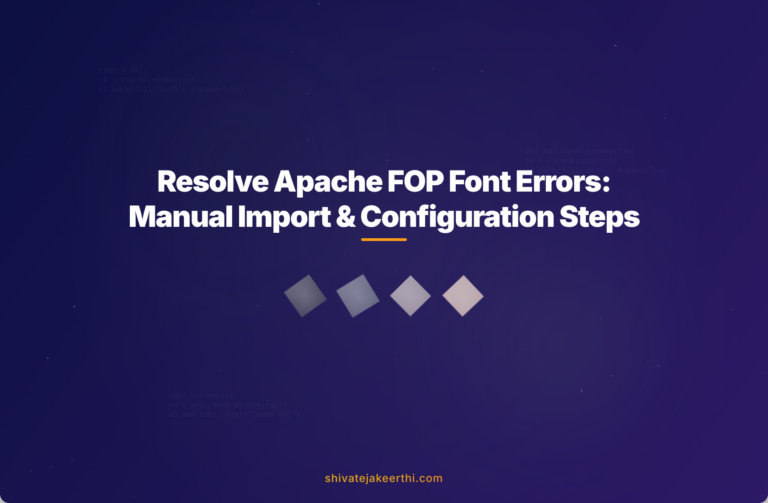When generating PDFs from documents using Apache FOP, one of the common issues developers face is the infamous font not found error, particularly when dealing with special glyphs or characters. This problem arises because Apache FOP needs explicit instructions on loading and utilizing fonts, especially ones containing complex or uncommon characters. Without proper handling, these special glyphs can cause PDF documents to render incorrectly or even fail altogether.
Ensuring Apache FOP correctly handles fonts with special glyphs isn’t just about aesthetics. It’s essential for accurate document representation, especially for internationalization projects, where missing characters can mislead readers or compromise content integrity.
What Causes Apache FOP Font Not Found Issues?
Apache FOP, short for Formatting Objects Processor, generates PDFs from XML documents using XSL-FO standards. While Apache FOP does an efficient job handling basic fonts out of the box, complex scenarios involving rare or international fonts require extra configuration effort.
The main cause behind font-related issues is Apache FOP’s reliance on clearly defined font-configuration steps. Apache FOP does not automatically retrieve fonts provided by the operating system, instead, it needs a direct reference through a configuration file or embedded resources.
When attempting to render special glyphs (like accented characters, symbols, or emojis), Apache FOP may fail if it can’t find these glyphs within available fonts or the configured directories. What’s worse, this failure often occurs silently, resulting in improperly rendered PDFs with missing or incorrect characters.
Practical Ways to Resolve the Font Not Found Issue in Apache FOP
Import Fonts Manually into Apache FOP
The simplest way to resolve missing font issues is manually importing the required fonts into Apache FOP’s environment. Here’s a clear step-by-step breakdown:
- Locate Your Fonts: Obtain TTF (TrueType) or OTF (OpenType) font files that contain your required glyphs—sources can range from Google Fonts to official font repositories.
- Create Metrics XML: Apache FOP uses font metric files to correctly map glyphs. Generate metric XML using Apache FOP’s built-in command-line tool:
fop-ttfreader your-font.ttf your-font-metrics.xml - Place Fonts and Metrics: Store your fonts and their corresponding metrics in an easily accessible directory within your FOP installation.
Avoid common pitfalls:
- Ensure font files aren’t corrupted.
- Always verify the metrics XML generation.
- Double-check paths and permissions—incorrect configurations here often cause confusion later.
Configuring Apache FOP Using fop.xconf
The recommended best-practice solution is setting up fonts through the FOP configuration file, fop.xconf. Doing this ensures consistent behavior across your PDF rendering.
To register fonts from a specific directory, configure your fop.xconf as:
<fop version="1.0">
<renderers>
<renderer mime="application/pdf">
<fonts>
<directory>/path-to-font-directory</directory>
<auto-detect/>
</fonts>
</renderer>
</renderers>
</fop>
Recursive Font Detection: Apache FOP can recursively detect all fonts in the provided directory structure, saving manual metric generation effort.
Apache FOP can also autodetect fonts installed on your operating system. Add the <auto-detect/> tag, and it simplifies the setup. However, explicitly declaring your fonts via manual import provides greater control and predictability than relying completely on automatic detection.
Troubleshooting Tips When Font Loading Goes Wrong
Sometimes even after configuration, fonts may fail. Here are practical troubleshooting methods:
- Analyzing Error Logs: Examine Apache FOP logs closely to pinpoint exact font errors—often, logs clearly state which characters or files cause trouble.
- Check Font Compatibility: Apache FOP typically supports TrueType (.ttf) and OpenType (.otf) fonts. Ensure you’re using supported file formats and avoid proprietary or legacy formats.
- Test Fonts Independently: Open your chosen font files separately in editors or word processors. If a font works properly in these apps but not with Apache FOP, confirm your metrics XML and configuration files once more.
Real-Life Examples and Solutions
A common practical example occurs when generating multilingual PDF reports involving European or Asian languages. Suddenly, certain accented or special characters don’t appear, resulting in an unreadable or partial PDF.
One developer on Stack Overflow faced precisely this scenario with German umlauts (ä, ü, ß). By manually importing a Unicode-compatible font, generating correct font metrics, and configuring fop.xconf, this problem was resolved.
Best Practices for Managing Fonts and Special Glyphs
Optimize your document generation setup and prevent future crises by adhering to these strategies:
- Choose Comprehensive Fonts: Select fonts that support extensive Unicode ranges. Fonts like Roboto, Noto Sans, or Arial Unicode MS can handle a vast spectrum of glyphs and languages.
- Maintain a Centralized Font Library: Having all fonts centralized simplifies management and troubleshooting. Regularly audit and update this repository to stay ahead of potential issues.
- Version Control Font Assets: Like your project code, keep font and metrics files under version control in systems like Git. Mistakes become easier to roll back, and collaboration is streamlined.
Embracing Unicode and Internationalization
As your application grows in complexity or geographical scope, robust font handling becomes essential not just technically but also strategically. Clear readability across languages and symbols helps bridge communication more effectively and ingrains accessibility and inclusivity deeply into your product’s core design.
The process detailed above might seem cumbersome initially, but with repeated practice and disciplined organization, effectively configuring Apache FOP quickly becomes routine.
Have you encountered unusual font-handling challenges with special glyphs or international characters in Apache FOP? Share your experiences or ask your questions—and perhaps even help a fellow reader facing similar issues.



0 Comments